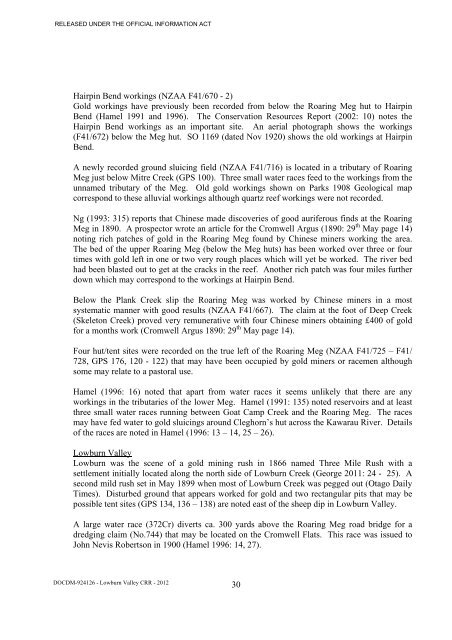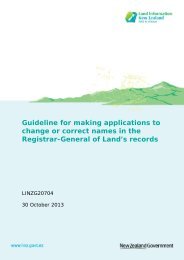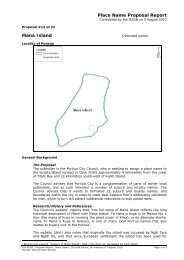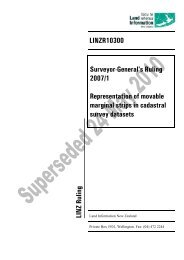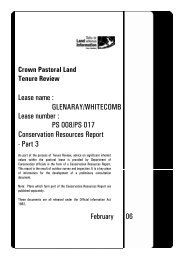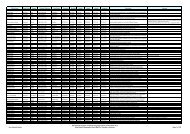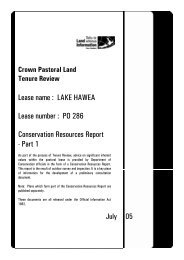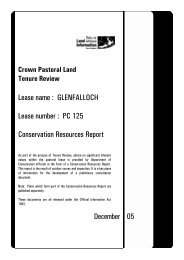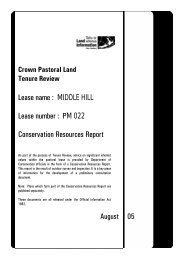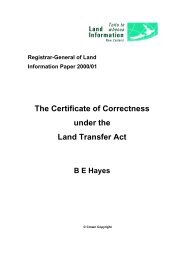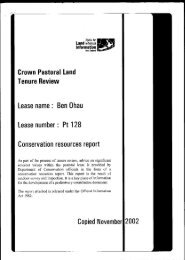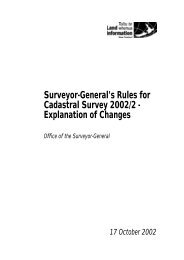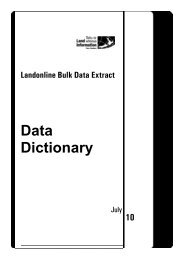Part 1 - Land Information New Zealand
Part 1 - Land Information New Zealand
Part 1 - Land Information New Zealand
Create successful ePaper yourself
Turn your PDF publications into a flip-book with our unique Google optimized e-Paper software.
RELEASED UNDER THE OFFICIAL INFORMATION ACT<br />
Hairpin Bend workings (NZAA F41/670 - 2)<br />
Gold workings have previously been recorded from below the Roaring Meg hut to Hairpin<br />
Bend (Hamel 1991 and 1996). The Conservation Resources Report (2002: 10) notes the<br />
Hairpin Bend workings as an important site. An aerial photograph shows the workings<br />
(F41/672) below the Meg hut. SO 1169 (dated Nov 1920) shows the old workings at Hairpin<br />
Bend.<br />
A newly recorded ground sluicing field (NZAA F41/716) is located in a tributary of Roaring<br />
Meg just below Mitre Creek (GPS 100). Three small water races feed to the workings from the<br />
unnamed tributary of the Meg. Old gold workings shown on Parks 1908 Geological map<br />
correspond to these alluvial workings although quartz reef workings were not recorded.<br />
Ng (1993: 315) reports that Chinese made discoveries of good auriferous finds at the Roaring<br />
Meg in 1890. A prospector wrote an article for the Cromwell Argus (1890: 29 th May page 14)<br />
noting rich patches of gold in the Roaring Meg found by Chinese miners working the area.<br />
The bed of the upper Roaring Meg (below the Meg huts) has been worked over three or four<br />
times with gold left in one or two very rough places which will yet be worked. The river bed<br />
had been blasted out to get at the cracks in the reef. Another rich patch was four miles further<br />
down which may correspond to the workings at Hairpin Bend.<br />
Below the Plank Creek slip the Roaring Meg was worked by Chinese miners in a most<br />
systematic manner with good results (NZAA F41/667). The claim at the foot of Deep Creek<br />
(Skeleton Creek) proved very remunerative with four Chinese miners obtaining £400 of gold<br />
for a months work (Cromwell Argus 1890: 29 th May page 14).<br />
Four hut/tent sites were recorded on the true left of the Roaring Meg (NZAA F41/725 – F41/<br />
728, GPS 176, 120 - 122) that may have been occupied by gold miners or racemen although<br />
some may relate to a pastoral use.<br />
Hamel (1996: 16) noted that apart from water races it seems unlikely that there are any<br />
workings in the tributaries of the lower Meg. Hamel (1991: 135) noted reservoirs and at least<br />
three small water races running between Goat Camp Creek and the Roaring Meg. The races<br />
may have fed water to gold sluicings around Cleghorn’s hut across the Kawarau River. Details<br />
of the races are noted in Hamel (1996: 13 – 14, 25 – 26).<br />
Lowburn Valley<br />
Lowburn was the scene of a gold mining rush in 1866 named Three Mile Rush with a<br />
settlement initially located along the north side of Lowburn Creek (George 2011: 24 - 25). A<br />
second mild rush set in May 1899 when most of Lowburn Creek was pegged out (Otago Daily<br />
Times). Disturbed ground that appears worked for gold and two rectangular pits that may be<br />
possible tent sites (GPS 134, 136 – 138) are noted east of the sheep dip in Lowburn Valley.<br />
A large water race (372Cr) diverts ca. 300 yards above the Roaring Meg road bridge for a<br />
dredging claim (No.744) that may be located on the Cromwell Flats. This race was issued to<br />
John Nevis Robertson in 1900 (Hamel 1996: 14, 27).<br />
DOCDM-924126 - Lowburn Valley CRR - 2012<br />
30


